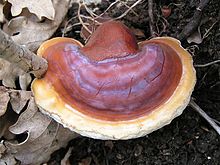|
Ganoderma
Ganoderma is a genus of polypore fungi in the family Ganodermataceae that includes about 80 species, many from tropical regions.[1] They have a high genetic diversity and are used in traditional Asian medicines. Ganoderma can be differentiated from other polypores because they have a double-walled basidiospore. They may be called shelf mushrooms or bracket fungi. Description Ganoderma are characterized by basidiocarps that are large, perennial, woody brackets also called "conks". They are lignicolous and leathery either with or without a stem. The fruit bodies typically grow in a fan-like or hoof-like form on the trunks of living or dead trees. They have double-walled, truncate spores with yellow to brown ornamented inner layers. TaxonomyTaxonomic historyThe genus Ganoderma was established as a genus in 1881 by Karsten and included only one species, G. lucidum (Curtis) Karst.[2] Previously, this taxon was characterized as Boletus lucidus Curtis (1781) and then Polyporus lucidus (Curtis) Fr. (1821) (Karsten 1881). The species P. lucidus was characterized by having a laccate (shiny or polished) pileus and stipe, and this is a character that Murrill suspected was the reason for Karsten's division because only one species was included, G. lucidum .[3] Patouillard revised Karsten's genus Ganoderma to include all species with pigmented spores, adhering tubes and laccate crusted pilei, which resulted with a total of 48 species classified under the genus Ganoderma in his 1889 monograph.[4][3][5] Until Murrill investigated Ganoderma in North America in 1902, previous work had focused solely on European species including, for example, G. lucidum, G. resinaceum Boud. (1890) and G. valesiacum Boud. (1895).[6][7][3] Notable species
PhylogenyThe genus was named by Karsten in 1881.[12] Members of the family Ganodermataceae were traditionally considered difficult to classify because of the lack of reliable morphological characteristics, the overabundance of synonyms, and the widespread misuse of names.[13][14] Until recently, the genus was divided into two sections – Ganoderma, with a shiny cap surface (like Ganoderma lucidum), and Elfvingia, with a dull cap surface (like G. applanatum). Phylogenetic analysis using DNA sequence information have helped to clarify our understanding of the relationships amongst Ganoderma species.[15][16] The genus may now be divided into six monophyletic groups:[17]
With the rise of molecular phylogenies in the late 20th century, species concept hypotheses were tested to determine the relatedness amongst the nuanced morphological variabilities of the laccate Ganoderma taxa. In 1995, Moncalvo et al constructed a phylogeny of the rDNA, which was the universally accepted locus at that time, and found five major clades of the laccate species amongst the 29 isolates tested.[18] It turned out that G. lucidum was not a monophyletic species, and further work needed to be done to clarify this taxonomic problem. They also found that G. resinaceum from Europe, and the North American 'G. lucidum', which Adaskaveg and Gilbertson found to be biologically compatible in vitro, did not cluster together.[18][19] Moncalvo et al. reject biological species complexes as a sole tool to distinguish a taxon, and suggested using a combination between biological and phylogenetic species concepts to define unique Ganoderma taxa.[19][18] In 1905, American mycologist William Murrill delineated the genus Tomophagus to accommodate the single species G. colossus (then known as Polyporus colossus) which had distinctive morphological features that did not fit in with the other species.[20] Historically, however, Tomophagus has generally been regarded as a synonym for Ganoderma.[21] Nearly a century later, phylogenetic analyses vindicated Murrill's original placement, as it has shown to be a taxonomically distinct appropriate genus.[17] EtymologyThe name Ganoderma is derived from the Greek ganos/γάνος "brightness, sheen", hence "shining" and derma/δέρμα "skin".[22][citation needed] EcologySome Ganoderma species can cause major long-term crop losses, especially with trees:
Ganoderma are wood-decaying fungi with a cosmopolitan distribution. They can grow on both coniferous and hardwood species. They are white-rot fungi with enzymes that allow them to break down wood components, such as lignin and cellulose. There has been significant research interest on the wood-degrading enzymes of Ganoderma species for industrial applications, such as biopulping[24][25] and bioremediation.[26] Uses For centuries, Ganoderma species have been used in traditional medicine in many parts of Asia.[27] These species are often mislabeled as 'G. lucidum', although genetic testing has shown this to be multiple species such as G. sichuanense (=G. lingzhi), and G. multipileum.[28][29] Several species of Ganoderma contain diverse phytochemicals with undefined properties in vivo, such as triterpenoids and polysaccharides, an area of investigation under basic research.[27] Although various Ganoderma species are used in traditional medicine for supposed benefits and have been investigated for their potential effects in humans, there is no evidence from high-quality clinical research that Ganoderma as a whole mushroom or its phytochemicals has effects in humans, such as in treating cancer.[30] See alsoReferences
|
